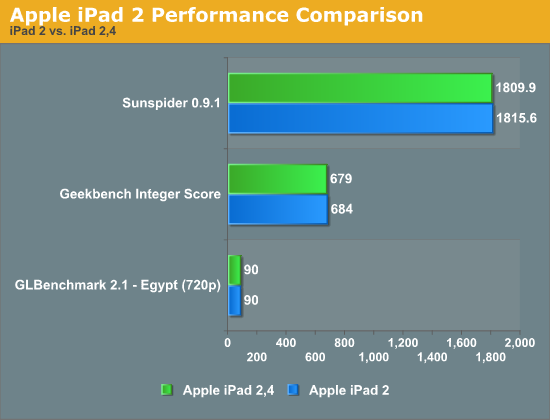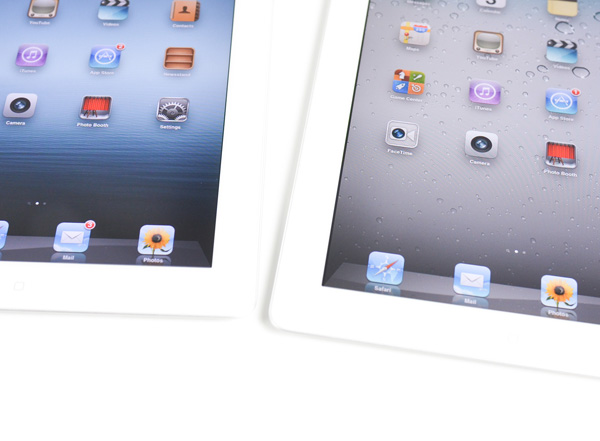The iPad 2,4 Review: 32nm Brings Better Battery Life
by Anand Lal Shimpi on May 4, 2012 12:50 AM ESTDecreased Power Consumption
We obviously know the impact of the new SoC on battery life but here's a look at just how much less power the new platform draws in various conditions. Note that for whatever reason the iPad's power consumption when sitting at the home screen is actually higher than when running our 720p High Profile video playback test. The results were consistent as I tested multiple times across multiple iPads. I have a few thoughts as to what could be happening here:
| Tablet Power Consumption (including Display) | ||||||
| iPad 2,4 | iPad 2 | iPad (3rd generation) | ||||
| Homescreen | 2.7 W | 2.9 W | 6.1 W | |||
| Sunspider | 3.4 W | 4.3 W | 7.6 W | |||
| Moonbat (20 x 4) | 3.9 W | 5.0 W | 8.3 W | |||
| GLBench Egypt (native res) | 3.8 W | 4.5 W | 9.6 W | |||
| GLBench Egypt (offscreen 720p) | 4.1 W | 4.8 W | 10.0 W | |||
| Infinity Blade 2 | 4.3 W | 5.1 W | 10.3 W | |||
| Riptide GP | 3.9 W | 4.7 W | 10.2 W | |||
| Video Playback (720p HP) | 2.2 W | 2.4 W | 4.9 W | |||
Under heavy CPU load (multithreaded Sunspider) we see a 28% increase in power consumption from the 45nm iPad 2,1 compared to the newer 2,4. Keep in mind that we're looking at peak power consumption here, which helps explain the smaller gap on the GPU side than what we saw in our battery life tests. What this data does show however is that the power efficiency improvements can be just as significant for CPU bound workloads, it's simply harder to find workloads that are CPU bound for long periods of time.
Looking at the 3rd generation iPad data reminds us of just how power hungry that platform is. It truly is Apple's performance halo, and it's the perfect target for a 32nm SoC in the future.
The iPad 2 battery life comparison numbers were generated on a lightly used iPad 2 with fewer than 20 charge cycles. While it's possible that some of the differences highlighted on the previous page are due to differences in the batteries between these two devices, it's likely that the variance is in the single digit range at best due to the limited number of charge cycles on the iPad 2 (Update: we confirmed the delta between our iPad 2 results and a brand new, out of box 45nm iPad 2 was < 3%). The power consumption numbers above remove the battery from the equation and help to validate these numbers.
Slightly Improved Thermals
I ran the same temperature test I did for our iPad review: measure maximum surface temperature of the tablet after a 1 hour loop of Infinity Blade 2. The results aren't surprising:
| Thermal Comparison (Max Temperature) | ||||||
| iPad 2,4 | iPad 2 | iPad (3rd generation) | ||||
| Infinity Blade 2 (1 hour) | 33.2˚C | 34.2˚C | 41.9˚C | |||
The iPad 2,4 manages to shave off a degree of surface temperature. It's not really noticeable, but it's there.
Performance
There's no performance difference between the iPad 2,4 and the older iPad 2 models. Regardless of whether you're looking at CPU or GPU performance, the new and older iPad 2s are indistinguishable. Apple definitely embraced the console mentality with this launch.

One difference you will notice between iPads however is variance in the panel vendor and resulting performance. Similar to what we've reported on in the Mac space, Apple likes to get 2 - 3 vendors for most components with very few exceptions (e.g. the CPU/GPU/SoC). We've seen this primarily be an issue with displays and storage devices in Macs, but on the iPad/iPhone side of the fence it can definitely be noticeable as the display plays such a major role in the experience with these devices.
The iPad 2,4 I'm reviewing has noticeably different display characteristics compared to my older iPad 2. My 2,4 sample has a higher maximum brightness (and black level), better grayscale color accuracy, and lower color temperature (more yellow). The new panel isn't any worse than what we've reviewed previously, in fact it's actually slightly better in a number of areas, although some users may be put off by the lower white point temperature (6200K vs. 6600K).
The panel I ended up with here isn't specific to the 2,4, but rather something you could end up with in any iPad 2 model. This is nothing new, but it's always interesting to get an idea of the amount of variance Apple considers acceptable. The new iPad still appears to be in the single or dual source stage (there's conflicting information about whether or not LG made panels are also available today). Sharp is expected to come online in the near future as another source. It remains to be seen how those panels will fare compared to the excellent Samsung panel that Apple launched with however.











100 Comments
View All Comments
marioyohanes - Friday, May 4, 2012 - link
Unfortunately, if you bought iPad 2 after iCloud launched, you'll get iCloud logo on the box anyway. Late 2011 production to be exact. Since I have 2 different iPad 2, one I bought on April, and another one after 4S launched, the later has iCloud logo.Souka - Friday, May 4, 2012 - link
Did anyone by chance OPEN one of these new iPads and look at the battery?Is is the same as the "older" iPad2? Or possibly a slightly higher capacity?
I didn't see any mention in the article so it made me wonder, that's all.
:)
lolstebbo - Friday, May 4, 2012 - link
Ah. Odd, but makes sense.dasartis - Friday, May 4, 2012 - link
Does anyone know how to check to see what the version number is using a method other than geekbench? It's $0.99 in the app store, and I wouldn't use it for anything other than the version check.frederickd - Friday, May 4, 2012 - link
I just used Battery Life Pro to find out my iPad is a 2,4. Battery Life Pro is free and has a button with the picture of a computer chip on it. Touch that and then go to System Info and you have the informaiton. Hope this helps.Dutchdaun - Monday, October 15, 2012 - link
Go to the Settings icon, General, Info, Diagnosis and Usage, Dianosis and Usage, and open one of the .plist files. In the second or third line is the model number. Be awere, I translated the menu items from the Dutch language so the menu items could be labeled otherwise in English.iwod - Friday, May 4, 2012 - link
Any reason why Apple would want to use TSMC instead? I am guessing the cost of the new A5R is roughly the same because the Wafer cost is much higher and you get less yield.CoreDuo - Friday, May 4, 2012 - link
Because these days Samsung isn't only their supplier, but they're a main competitor as well.dagamer34 - Friday, May 4, 2012 - link
For Apple, that's a silly reason, since they make far more money off of selling their products than they would ever get from patents and Samsung is a rock solid supplier going as far back as the original iPhone.They may want some diversity, but because Samsung and Apple actually need each other, they aren't going to stupidly turn down each other's business. Note that while their lawyers might fight, shareholders would NOT be happy with the amount of lost business/production of product.
medi01 - Friday, May 4, 2012 - link
Which "money from patents" are you talking about, my dear?Apple didn't try to get money for it's "patents" (getting payed for "rectangular shape with rounded corners" would be hilarious, though), they've "merely" went "thermonuclear" (c) Hypnosteve to STOP Samsung's product altogether.
And they, in fact, succeded in doing it in Germany, thanks to the reasonable judge, Johanna Brueckner-Hofmann. Now Germans get "N" version of 10.1, with silly looking ears. (no ears design is patented, you know)